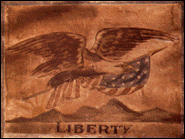

![]()
![]()
![]()
![]()
One final accomplishment of the Revolutionary generation was the creation of a viable national government. Without it, all other gains of the period might have amounted to little. Since that achievement had not taken place by 1783, the leaders of the time felt that the Treaty of Paris did not mean the end of the American Revolution. As the poet Joel Barlow explained, "The revolution is but half completed. Independence and government were the two objects contended for; and but one is yet obtained."
The task of preparing a constitution for the new nation had begun in 1776 in the Continental Congress, when that body worked to define the relations of the states to one another and to the nation. In doing so, Congress found that the old colonial jealousies still existed, as did the suspicions of remote, centralized authority that had led the colonists to criticize and break their ties with the king and Parliament. Consequently, the first national constitution, the Articles Of Confederation, was not completed until 1777 and not ratified by all the states until 1781, and it provided for a government of limited national jurisdiction. It was an instrument of one branch, Congress, which now was given legal authority to do what it was already doing in large part in attempting to direct the war effort. Congress was to have exclusive authority over foreign relations, war and peace, weights and measures, admiralty cases, Indian relations outside the boundaries of individual states, and postal services. Congress was crippled in crucial ways, however, especially in obtaining revenues; for it could not tax or levy duties on external commerce, nor did it have legal ways to enforce its legitimate authority if the states chose to disregard its laws.
As the war approached its end, the states displayed less willingness to cooperate with Congress and to support its acts, a trend that grew ominous after the treaty of peace. It was especially depressing to those who had become ardent nationalists through their wartime experiences to see the states ignore the Articles of Confederation by making treaties with the Indians and building state navies, or by failing to send representatives to Congress and neglecting to contribute sums for the support of the Confederation government. To nationalists such as Washington, Alexander Hamilton, James Madison, Henry Knox, and others, a new political system altogether was needed, particularly because all efforts to amend the articles had failed. To that end, the Constitutional Convention, which met at Philadelphia in 1787, decided to try a different form of government--one that would ensure the rights of the states and at the same time provide the country with a central government capable of maintaining domestic tranquillity, preserving individual liberty, providing for the common defense, and raising the status of America in the family of nations.
~ The Reaction ~
The result was the federal Constitution Of The United States, which was approved by the states in ratifying conventions in 1788, despite the cries of opponents that such a powerful government would tyrannize the states and their citizens. The new constitution was federal, in that powers were separated and divided between the national and state governments, both with their own jurisdictions. By turning to federalism the 55 men at Philadelphia solved what had been the central problem of American political history in the quarter century since the end of the French and Indian War, namely, how governmental power should be allocated. First, the question was between Parliament and the colonial assemblies; later, between Congress under the Articles of Confederation and the state legislatures. The American Revolution reached its culmination when the Constitution was adopted in 1788.
![]()

![]() Exciting?
Then go on! What's up?
Exciting?
Then go on! What's up? ![]()